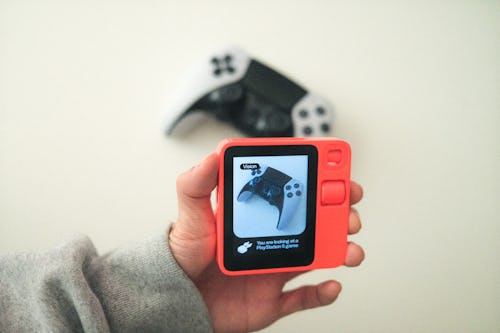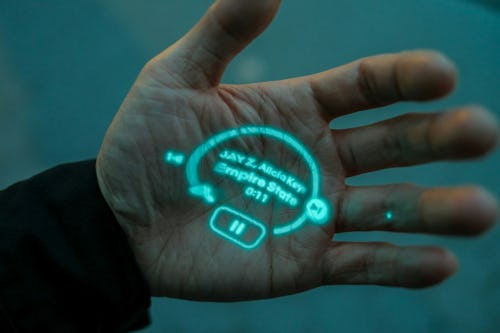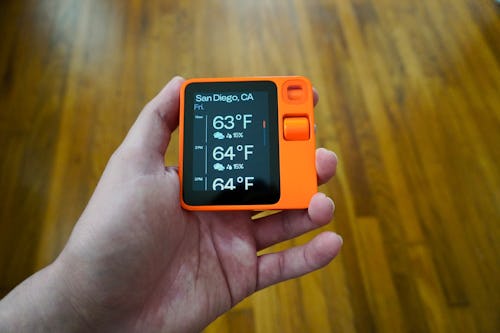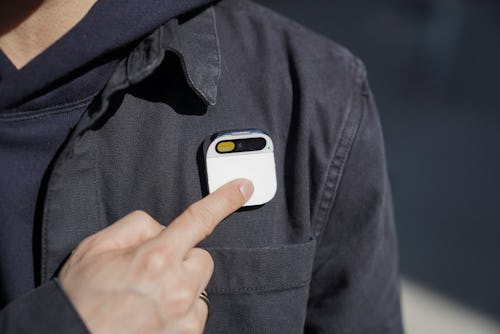
What do we really know about a good AI gadget? And is there ever a “good” when you can theoretically improve something forever? These are the two questions that current AI hardware is dealing with — and largely failing to answer.
The Humane Ai Pin launched to, at best, open-minded reviews, with the device’s issues with overheating and slow response times often outweighing the idea that a wearable you can talk to (that’s not on your wrist) might be a good idea. The company has promised fixes, and new features, and has shown a willingness to hear feedback, but largely seems unphased that the product it shipped was unfinished.
By being radically cheaper, the Rabbit R1 earned a lot of goodwill upfront. A design from Teenage Engineering didn’t hurt either. But based on my brief time with my own R1, even if it looks and feels fun, it doesn’t do everything it was introduced as being able to handle, and the things it can do aren’t nearly as detailed or rich. Rabbit, like Humane, has promised future updates and has been addressing customer issues on social media, but overall the company appears satisfied with what it shipped.
This is, for anyone who reads and cares about product reviews, kind of confusing. But it’s also reflective of what’s strange about AI hardware in general. These products can seemingly turn on a dime, going from providing wrong answers to right answers in a matter of hours. They’re never really finished because they can be updated quickly and perpetually.
Head In the Clouds

Neither the Rabbit R1 nor the Humane Ai Pin are technically “headless” in the sense that they lack a graphical user interface to interact with, but they prioritize using your voice and obscure what’s actually happening on the device. The intentions here are pure. It should feel more natural to verbally ask for something than to fiddle with menus. But the problem, as many have pointed out, is that talking to yourself isn’t appropriate in every setting.
The Ai Pin work around this problem with a projector and the R1 with a small touchscreen, but in most cases, you’re still just making a voice request and waiting for a response. The magic is supposed to happen on the backend with AI frameworks, large language models, and large action models (LAM) doing the work of interpreting what you want, connecting you to information from the correct service, interacting with those services on your behalf, and delivering the answer you’re looking for.
But there’s never a way to know what your device is actually doing to produce the answer it gives you. There’s only the answer itself, whether it makes sense or doesn't, and is correct or not. Despite producing attractive shells at an expensive or approachable price point, the product Humane and Rabbit are selling is more of a software experience than a hardware one. And it’s software that can be tweaked remotely in ways that would normally require downloading a whole new software update.
It Can Always Get Better

Both Humane and Rabbit have summer updates planned that they claim will introduce features promised at launch and new ones that make sense for their different form factors. Both devices have also been tinkered with since they got in the hands of customers. When my colleague Raymond Wong asked the Rabbit R1 what the current time was on launch day, it not only displayed the wrong time on screen, but verbally responded with a time that was 16 minutes off. That’s since been fixed and Rabbit CEO Jesse Lyu claims an upcoming over-the-air update will improve battery life and “reduce hallucinations” even further.
Humane currently maintains a public changelog of the tweaks it’s made to its backend and to the Cosmos operating system on the Ai Pin itself. Based on an update published to its blog, the company’s current focus is “improving battery life and thermal management” on the Ai Pin, reducing the time it takes to respond to requests, and “fine tuning accuracy for a smoother experience.”
Once both companies actually get their gadgets working entirely how they’re supposed to, it really does feel like there might be blue skies ahead in terms of the kind of things these products could do. By relying on models made by other companies (and in the case of Rabbit, any apps it can train its LAM to use) your Ai Pin or R1 could theoretically grow in functionality indefinitely as long as AI models continue to improve.
We’ve Already Reached the Ceiling

Viewed another way, though, the fact these devices shipped unfinished might be a sign that we’re already brushing up against a ceiling of what AI can actually do on its own. You’ll note that hallucinations can only ever be “reduced,” not eliminated. Features are “improved” and “tuned” not released in a functional state. Language models and the nebulous cloud of AI features that rely on them are too unpredictable to seemingly ever perfect.
Sam Altman, CEO of OpenAI, who provides the GPT model that both Humane and Rabbit use in one way or another, was reportedly seeking trillions of dollars to address a hardware bottleneck OpenAI was facing in the development of its future models. That’s spending the value of an Apple or a Microsoft to release a theoretical GPT-6 or 7. At what point does creating a better version of the AI chatbots we have cost more than they’ll ever be worth?
And chips aren’t the only problem. The data used to train AI models is running out. The New York Times reports companies will run out of high-quality web data to train models by 2026. Companies developing AI models are already considering other sources, like buying whole publishing houses or using AI-generated text for training. All for somewhat natural language and frequently inaccurate responses?
When the Unknown Is a Product
There’s something legitimately exciting about new ideas and new products. Especially when they’re offering an experience that’s different from the Siris and Alexas that came before them. That sense of potential is the best part of the current wave of AI hardware. Maybe we really are going somewhere new and maybe the journey to get there never has to end.
But the open-endedness of current products like the Humane Ai Pin and the Rabbit R1 also easily acts as cover for an experience that’s frequently frustrating right now. And that’s a sense of frustration neither company is promising to eliminate because they simply can’t. They’re selling hope for a future in a way few actually useful consumer products ever have. And it’s not even a very detailed future. At no point in my short time using the R1 have I felt like it came to me with a purpose. I don’t think it should necessarily be the customer's job to figure that out, even if it’s fun. None of these AI gadgets are finished, because that sense of the unknown — and all the good and bad things it can encompass — is the product.
FTTT
0 Comments